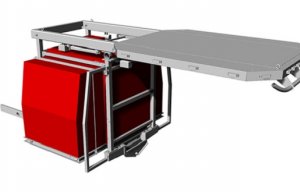
Lightweight fiberglass tank for off-road fire tanker
Teijin Techno Products Limited, the core company of the Teijin Group's aramid fibres business, together with the New Energy and Industrial Technology Development Organization (NEDO) and Hosokawa Micron Corporation, have announced the development of a new fabric incorporating nanostructure fibre for use in advanced fire fighting suits. Teijin Techno says the new fabrics are 40% more effective in preventing burns than fabrics without nanostructure fibre and 15% lighter tha

29th January 2010
Innovation in Textiles
|
Tokyo
 Teijin Techno Products Limited, the core company of the Teijin Group's aramid fibres business, together with the New Energy and Industrial Technology Development Organization (NEDO) and Hosokawa Micron Corporation, have announced the development of a new fabric incorporating nanostructure fibre for use in advanced fire fighting suits. Teijin Techno says the new fabrics are 40% more effective in preventing burns than fabrics without nanostructure fibre and 15% lighter than conventional heat-barrier linings.
Teijin Techno Products Limited, the core company of the Teijin Group's aramid fibres business, together with the New Energy and Industrial Technology Development Organization (NEDO) and Hosokawa Micron Corporation, have announced the development of a new fabric incorporating nanostructure fibre for use in advanced fire fighting suits. Teijin Techno says the new fabrics are 40% more effective in preventing burns than fabrics without nanostructure fibre and 15% lighter than conventional heat-barrier linings.
The nanostructure fibre is made by kneading nano sized carbon particles into Technora fibre, Teijin Techno Products’ high-performance para-aramid fibre offering high strength, heat resistance, dimensional stability and chemical resistance.
According to Teijin Techno Products, the two basic functions of fire fighting suits are flame and heat barrier properties and comfort to alleviate fatigue and heatstroke. The company says that until now, it has been technically difficult to combine both at a high level, but that the new fabric realizes both functions in the heat-barrier layer, a lining serving as the innermost of three layers in fire fighting suits.
The key development was the uniform dispersion of nano sized carbon particles in Technora aramid fibre to substantially increase thermal conductivity compared to ordinary aramid fibre, allowing the efficient diffusion and radiation of heat reaching the inside of the suit. Teijin Techno Products says its tests show that suits lined with the new fabric are 40% better in preventing second and third degree burns compared to suits that do not use nanostructure fibre. In addition, the fabric lowers the weight of the heat-barrier layer by 15% compared to conventional linings capable of equivalent heat resistance, Teijin Techno says.
The company says that the fabric satisfies both North American heat-barrier performance standards, thought to be the world’s strictest for fire fighting suits, and Japanese fire fighting suit standards, which are among the worlds most demanding in terms of comfort.
Teijin Techno Products and Hosokawa Micron, working under NEDO’s Research and Development of Nanodevices for Practical Utilization of Nanotechnology (Nanotech Challenge Program), collaborated to create the fabric. Hosokawa Micron developed nano particles with superior heat resistance that can be uniformly dispersed in aramid fibre, and also established conditions for manufacturing the nano particles. Teijin Techno Products developed the nanostructure fibre by kneading the nano particles into Technora aramid fibre, and it also developed the stack structure to enable the fabric to be used as a lining in fire fighting suits.
Methods for analyzing and evaluating nanostructure fibre and particle dispersion were developed through an industry-government-academic collaboration led by Prof. Akihiko Tanioka at the Tokyo Institute of Technology and Prof. Hidehiro Kamiya at the Tokyo University of Agriculture and Technology.
Going forward, the two companies aim to establish technology to mass produce the fabric for commercial use in fire fighting suits as soon as possible. Meanwhile, they are attempting to knead different nano particles into aramid fibre to realize new or enhanced properties, such as electric conductivity and electromagnetic wave shielding, without impairing the intrinsic properties of aramid fibre. In addition, Teijin techno says it should be possible to improve combustion resistance and reduce heat shrinkage by adding nano particles of titania (titanium dioxide) and silica inorganic compounds. A variety of applications are expected to be found for advanced materials made of these new nanostructure fibres, especially applications in which organic materials cannot be used.

Business intelligence for the fibre, textiles and apparel industries: technologies, innovations, markets, investments, trade policy, sourcing, strategy...
Find out more